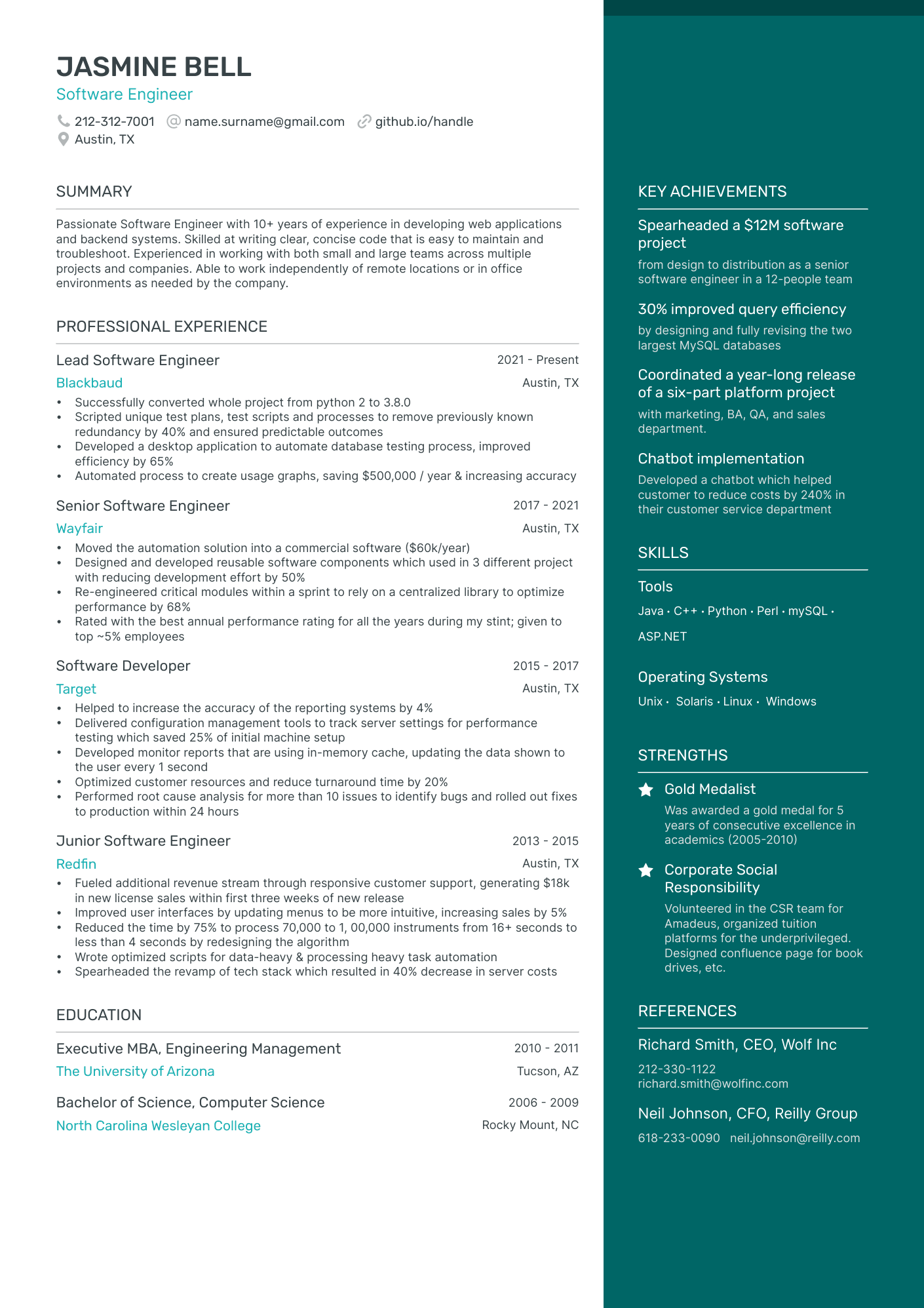With limited space on your resume and limited time recruiters spend on each application, you’re hard-pressed to make a strong impression. By presenting your top strengths in a clear, concise list, you’ll show HRs you’re a strong candidate and save them the time of digging through your resume for the information they need.
Placed strategically below your header, core competencies work like a spotlight, directing attention to your most valuable abilities from the get-go. Whether you’re a seasoned professional or transitioning into a new field, this resume section can make all the difference in capturing that elusive second glance.
Key takeaways
- Core competencies represent the skills, abilities, and knowledge that enable effective job performance.
- They go beyond technical skills, offering transferable strengths applicable across various roles and industries.
- You can highlight core competencies in a dedicated section or integrate them into your experience and summary sections.
- Aim to include five-ten core competencies to keep the section focused and impactful.
What are core competencies?
Core competencies are fundamental skills, abilities, and expertise that are integral to a person's ability to perform their job effectively. They can be a mix of both hard and soft skills, tailored to specific roles or industries. A few examples are analytical thinking, project management, and customer service.
How do core competencies differentiate from hard and soft skills?
Hard skills: These are teachable and measurable abilities, usually specific to certain jobs. Hard skills include things like proficiency in a foreign language, typing speed, or knowing how to use software like Microsoft Excel or Adobe Photoshop.
Soft skills: These are skills you develop throughout your personal and professional life. They enhance your interactions, job performance, and career prospects. Unlike hard skills, which are much more specific, soft skills are interpersonal and broadly applicable. Examples include communication, teamwork, flexibility, and problem-solving.
It’s important to know that core qualifications extend beyond concrete abilities like proficiency with specific software. For example, project management is a core competency, while using project management tools like Asana is a hard skill.
Why resume core competencies are important
There are two major reasons for including core competencies on your resume. The first one is to pass the ATS (Applicant Tracking Systems), and the other one—to impress the hiring manager.
Making your resume ATS-friendly
Nowadays, many companies use ATS to speed up the hiring process. These look for specific keywords from the job description and are sensitive to formatting.
So how to proceed?
- Match the keywords: It’s best if your core competencies match the keywords from the job description. That can boost your resume’s chances of passing through ATS filters.
- Format properly: You can list core competencies with bullets or divide them with the vertical bar | symbol. The Enhancv builder’s sections break up skills with minimalistic dots, which are guaranteed to pass the ATS screening.
Engaging HRs
That’s the more important part. If your core competencies section matches the key skills described in the job description, recruiters will respond to your application more quickly. Positioning them in a key spot on your resume means HRs will recognize them more quickly. This leads us to the next section.
How to put core competencies on a resume
Here’s how to develop this section in three easy steps.
Step 1. Make a list of your strongest skills and abilities
The first step to building your core competencies section is to make a list of all your strongest skills and abilities relevant to the position you’re applying for. The list should include anything that would fall in your resume skills section, but focus only on the strongest ones.
The list should consist of 10 to 30 skills or abilities and include a range of hard and soft skills. These may be obtained in an academic or a work setting, learned by mentors, or through various life situations.
Step 2. Tailor your core competencies section according to the job position
Tailoring your core competencies section clearly shows your interest in the specific position. So, take the list you created in the previous step and choose between five to ten competencies that are directly related to the job specifications. A focused selection helps you maintain the hiring manager’s attention and increases your chances for an interview.
While making your list, read the job description of the job you’re interested in for any keywords that you might be able to use. Try to make each ability unique and different to demonstrate you’re a multifaceted and adaptable employee.
Step 3. Keep it short, but not too short
Once you have shortened your list according to the position, you need to modulate it. In the core competencies section, you want to use no more than two words to describe each skill or ability.
Here’s how you can approach this:
Instead of saying Excellent communication skills, say Communication. Instead of Highly proficient in Microsoft Office, say Microsoft Office, and so on.
Where to put core competencies on a resume
When writing a resume, effectively placing your core competencies is essential. Here are some strategies for placing them on a resume, along with the pros and cons of each approach.
In a dedicated section
Create a specific section labeled “Core competencies” or “Core qualifications.” Place it just below your header, so that it grabs the reader’s attention immediately. You can format it as a list, table, or use the Skills or Additional skills section in our builder.
Pros:
- Clearly and quickly identifiable for hiring managers who skim resumes, as well as for ATS parsing.
- Allows for a comprehensive listing of skills, which can be tailored to match the job description.
- Easy to update and tailor for different job applications.
Cons:
- Separates skills from the context of where and how they were developed and applied.
- Takes up more space on the resume.
Example
Core competencies
- Project management
- Budgeting & Cost control
- Data analysis
- Team leadership
- Risk assessment & Mitigation
- Regulatory compliance
- Client relationship management
- AutoCAD & Civil 3D
- Cross-functional collaboration
- Problem-solving & Decision-making
In the professional summary or experience section
A less popular option, which can help save space, is to incorporate core competencies into your professional summary or experience section.
Pros:
- Quickly draws attention to your strengths right from the beginning.
- Saves space by combining your core competencies in a key section of your resume.
- Demonstrates your competencies in action, providing context to your achievements.
Cons:
- Limited space may restrict the detail of each competency in the summary.
- Can dilute the impact if not clearly highlighted or if mentioned too passively.
Here’s how you can incorporate them in your summary:
And in your experience section:
- •Specialized in project management, risk assessment, and budgeting & cost control.
- •Delivered projects on time and within budget while maintaining regulatory compliance.
- •Utilized AutoCAD and Civil 3D for infrastructure planning and execution.
- •Collaborated with cross-functional teams to achieve project milestones.
- •Managed client relationships, ensuring satisfaction and project success.
Strengths & achievements: a modern take on core competencies
In line with modern employers looking for concrete examples of the impact of your work, a more modern approach would be to create a Strengths & Achievements section. Open the editable template below to see an example.
When deciding where to place core competencies on your resume, align your strategy with your industry's preferences and the specific job requirements. Consider the space available on your resume—tech fields might prefer a detailed skills section, while creative roles may benefit from integrating skills within portfolio work.
Ultimately, choose a strategy that complements your resume's overall narrative and meets potential employers' expectations in your field.
Let’s see an example of incorporating your core competencies in an Achievements section:
PRO TIP
You can use the Enhancv online builder to create customized sections for all your competencies!
Examples of core competencies for different industries
Creating a targeted list of core competencies for resumes can significantly enhance a job applicant's chances of standing out.
Here’s a compilation divided into ten of the most popular industries:
Information technology
- Technical troubleshooting
- Network security
- Software development
- Data analysis
- Cloud computing
- Project management
- Machine learning
- UX design
- Mobile application development
- Agile methodologies
Healthcare
- Patient care
- Medical coding
- Emergency management
- Health administration
- Clinical procedures
- Medical record keeping
- Pharmacology
- Health education
- Regulatory compliance
- Telemedicine
Finance
- Financial analysis
- Risk management
- Budgeting
- Compliance
- Auditing
- Tax preparation
- Investment strategies
- Financial reporting
- Quantitative analysis
- Economic forecasting
Education
- Curriculum development
- Educational leadership
- Classroom management
- Special education
- Instructional design
- Educational technology
- Assessment design
- Student counseling
- Bilingual education
- Distance learning coordination
Marketing
- Digital marketing
- Market research
- Brand management
- Social media strategy
- Content creation
- SEO/SEM
- Data-driven marketing
- Customer Relationship Management (CRM)
- Event planning
- Conversion optimization
Engineering
- CAD software proficiency
- Project engineering
- Quality assurance
- Product development
- Manufacturing processes
- Structural analysis
- Lean manufacturing
- Sustainability solutions
- Electrical systems
- Automation
Retail
- Customer service
- Merchandising
- Inventory management
- Sales expertise
- Point of sale systems
- Loss prevention strategies
- Visual merchandising
- E-commerce
- Supply chain management
- Business operations
Hospitality
- Guest services
- Event management
- Hospitality administration
- Food and beverage management
- Housekeeping standards
- Reservation systems
- Travel coordination
- Customer satisfaction
- Conflict resolution
- Tourism knowledge
Manufacturing
- Production planning
- Quality control
- Machine operation
- Supply chain logistics
- Safety management
- Continuous improvement
- Process optimization
- Maintenance protocols
- Inventory control
- Regulatory standards
Legal
- Legal research
- Litigation management
- Corporate law
- Intellectual property
- Compliance and ethics
- Legal writing
- Mediation and arbitration
- Real estate law
- Contract negotiation
- Case management
Finally, let’s answer some common questions regarding putting your core competencies on your resume.
FAQs about core competencies on a resume
How do you answer “What are your core competencies?” in an interview?
To answer “What are your core competencies?” effectively, review the job description to identify key skills and qualities, prepare specific examples using the STAR method (Situation, Task, Action, Result), and connect these competencies to the role to show how they make you a suitable candidate.
How to write a core competency statement?
A core competency statement should be concise and specific, highlighting key strengths and skills relevant to the job. Use clear language, quantify achievements where possible, and tailor the statement to reflect the competencies most relevant to each job application.
How many core skills should I include on a resume?
Include about five to ten core skills on your resume, focusing on those most relevant to the job to keep the list targeted and concise. This approach ensures your resume captures the employer's interest without being overwhelming.
How to identify your core competencies?
Identify your core competencies by analyzing job descriptions for required skills, seeking feedback from colleagues and mentors, and considering your professional achievements. Reflect on the skills that have enabled your success, as these are likely your core competencies.
Conclusion
By displaying tailored core competencies on your resume, you underline your relevant skills and match job descriptions, which gives recruiters what they want to see. Blending technical and soft skills and backing them with examples, you create a dynamic profile that evolves with your career goals and stands out in the job market.
Make one that's truly you.





